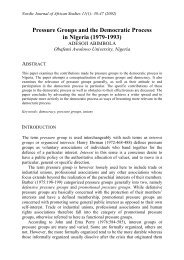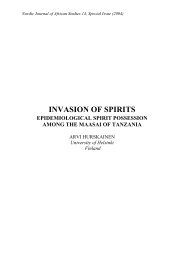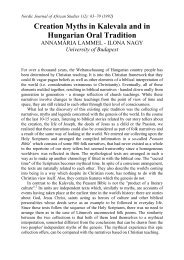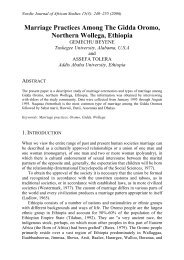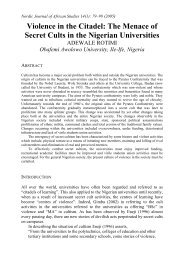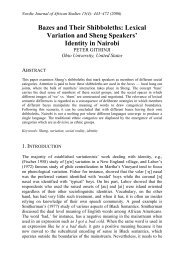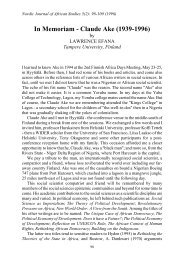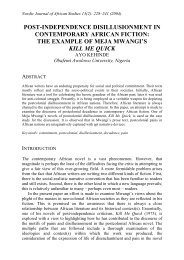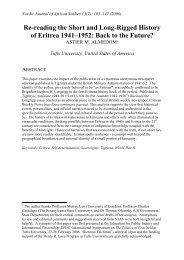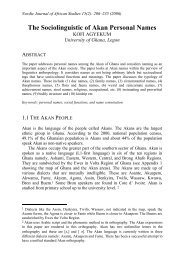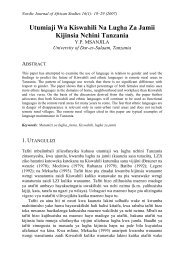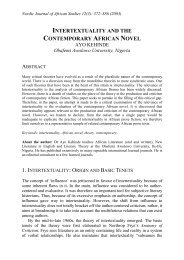Non-Native Perception and Interpretation of English Intonation
Non-Native Perception and Interpretation of English Intonation
Non-Native Perception and Interpretation of English Intonation
Create successful ePaper yourself
Turn your PDF publications into a flip-book with our unique Google optimized e-Paper software.
Nordic Journal <strong>of</strong> African Studies 14(1): 26–42 (2005)<br />
<strong>Non</strong>-<strong>Native</strong> <strong>Perception</strong> <strong>and</strong><br />
<strong>Interpretation</strong> <strong>of</strong> <strong>English</strong> <strong>Intonation</strong><br />
RAPHAEL O. ATOYE<br />
Obafemi Awolowo University, Ile-Ife, Nigeria<br />
ABSTRACT<br />
This paper investigated the perception <strong>and</strong> interpretation <strong>of</strong> a sub-class <strong>of</strong> sentence intonation by<br />
some Nigerian users <strong>of</strong> <strong>English</strong>. In a test administered to one hundred <strong>and</strong> twenty third-year<br />
university students <strong>of</strong> <strong>English</strong>, they obtained 85.7% correct perception <strong>of</strong> changes in intonation but<br />
obtained only 25.7% correct interpretation <strong>of</strong> the meanings normally associated with the intonation<br />
contours on the ten sentences played back to them. It was concluded from the analysis that the<br />
concept <strong>of</strong> intonation was well known to the subjects, though the attempt to teach them <strong>English</strong><br />
intonation through its structural analysis appeared not to have been very successful. The study<br />
recommends that emphasis should be placed on the teaching <strong>of</strong> the social meaning <strong>of</strong> <strong>English</strong><br />
intonation to non-native learners instead <strong>of</strong> the analysis <strong>of</strong> its phonological structure.<br />
Key Words: perception, intonation, non-native learners, phonology, <strong>and</strong> structure<br />
1. INTRODUCTION<br />
In a rather picturesque comment, Banjo (1979: 12) describes the appropriate use<br />
<strong>of</strong> stress <strong>and</strong> intonation as “the final hurdle, which a vast majority <strong>of</strong> speakers <strong>of</strong><br />
<strong>English</strong> as a foreign language never manage to cross”. In a more specific<br />
observation, Cruz-Ferreira (1989: 24) identifies intonation, <strong>of</strong> all the suprasegmental<br />
features, as “the last stronghold <strong>of</strong> a foreign accent in speaking any L2”<br />
asserting further that that observation is true “even <strong>of</strong> speakers who otherwise<br />
have perfect or near perfect comm<strong>and</strong> <strong>of</strong> the phonetics <strong>of</strong> the L2”. Not<br />
surprisingly, the intonation <strong>of</strong> non-native <strong>English</strong> poses serious intelligibility<br />
problems to native speakers <strong>of</strong> the language, as reported by Tiffen (1974) on<br />
Nigerian <strong>English</strong> <strong>and</strong> Bansal (1976) on Indian <strong>English</strong>. Bansal (ibid. 21) observes<br />
concerning the use <strong>of</strong> sentence stress <strong>and</strong> intonation in Indian <strong>English</strong> as follows:<br />
The sentence stress in Indian <strong>English</strong> is not always in accordance with the<br />
normal RP pattern <strong>and</strong> the characteristic rhythm is not maintained. The<br />
division <strong>of</strong> speech into sense groups <strong>and</strong> tone groups is sometimes faulty,<br />
<strong>and</strong> pauses are made at wrong places. The location <strong>of</strong> the intonation<br />
nucleus is not always at the place where it would be in normal <strong>English</strong>.<br />
The rising tone sometimes used at the end <strong>of</strong> statements must sound<br />
unusual to the RP-speaking listeners.
<strong>Non</strong>-<strong>Native</strong> <strong>Perception</strong> <strong>and</strong> <strong>Interpretation</strong><br />
The problem <strong>of</strong> intonation for the users <strong>of</strong> <strong>English</strong> as a second language has been<br />
accounted for in various ways. For example, Amayo (1981) has argued that the<br />
supra-segmental features, <strong>of</strong> which intonation is a major component, are generally<br />
more elusive than the segmental <strong>and</strong> are therefore more inherently difficult to<br />
learn for foreign learners. As further observed by that writer, the supra-segmental<br />
features, particularly intonation, are much less researched <strong>and</strong> are, consequently,<br />
much less taught than the segmental aspects <strong>of</strong> <strong>English</strong>. <strong>Intonation</strong> also remains<br />
the most neglected in second language acquisition research in general, for, as<br />
observed by Cruz Ferreira (1989: 24), it has only recently begun to be “seriously<br />
<strong>and</strong> systematically taken into account both in the literature devoted to foreign<br />
language learning <strong>and</strong> in teaching itself”. That situation is very true <strong>of</strong> intonation,<br />
as it is <strong>of</strong> all the other prosodies <strong>of</strong> <strong>English</strong> in Nigerian school education.<br />
Consequently, Jowitt (2000: 64), after an examination <strong>of</strong> the form <strong>and</strong> the<br />
frequency <strong>of</strong> intonation patterns in educated Nigerian spoken <strong>English</strong> concludes<br />
that “certain patterns having a high frequency, constitute a system in Nigerian<br />
usage differing in important respects from native-speaker systems, though lacking<br />
stability”. Adejuwon (2003) also found that a majority <strong>of</strong> the radio newscasters in<br />
South-western Nigeria neither understood the intonation tunes that were played<br />
back to them, nor did they employ such tunes in their own newscasts.<br />
One <strong>of</strong> the sources <strong>of</strong> the difficulty <strong>of</strong> <strong>English</strong> intonation for the foreign<br />
learner is, no doubt, the undue emphasis placed, in teaching, on its structural<br />
analysis rather than on its communicative value in EL2 programmes. Thus, the<br />
notions <strong>of</strong> tonality, tonicity <strong>and</strong> the tone group (Crystal 1972), also variously<br />
designated as the intonational phrase, phonological clause or sense group<br />
(Cruttenden 1990) are introduced to the foreign learner in that structuralist<br />
analysis expounded by Pike (1945), Abercrombie (1964), Kingdon, (1958) <strong>and</strong><br />
O’Connor <strong>and</strong> Arnold (1973), to mention a few classic examples. Consequently,<br />
the description <strong>of</strong> tone (a misnomer for intonation types or tunes) as rising <strong>and</strong><br />
falling, with many complex configurations such as ‘fall-rise’, ‘falling to mid’, <strong>and</strong><br />
‘low rising’ (Halliday 1967: 29) confuses the EL2 learner, whose primary<br />
business, like that <strong>of</strong> the non-linguist native speaker’s, is to use <strong>English</strong> intonation<br />
appropriately in everyday communication. Nor do the notions <strong>of</strong> tone group, foot<br />
<strong>and</strong> syllable (Halliday 1967: 12) help the non-native user <strong>of</strong> <strong>English</strong> to underst<strong>and</strong><br />
the language better. Even more perplexing is the demarcation <strong>of</strong> the tone group’s<br />
internal structure into the obligatory nucleus (the tonic or nuclear syllable) <strong>and</strong> the<br />
optional Head, Pre-head <strong>and</strong> Tail. As reported in an experiment (Currie 1980), a<br />
great deal <strong>of</strong> disagreement exists, even amongst trained phoneticians, on the<br />
identification <strong>of</strong> the tonic in sentences recorded from Edinburgh Scottish <strong>English</strong><br />
speakers. In a nutshell, the adoption <strong>of</strong> the structuralist framework for teaching<br />
intonation to learners <strong>of</strong> <strong>English</strong> as a second language, which is in vogue in many<br />
a university lecture hall today, may have achieved little success.<br />
27
Nordic Journal <strong>of</strong> African Studies<br />
2. INTONATION AND MEANING<br />
The relationship between intonation form <strong>and</strong> function has been recognized from<br />
very early times. Pike (1972: 56) states the communicative import <strong>of</strong> intonation<br />
very vividly in the following words:<br />
Actually, we <strong>of</strong>ten react more violently to the intonational meanings than<br />
to the lexical ones; if a man’s tone <strong>of</strong> voice belies his words, we<br />
immediately assume that the intonation more faithfully reflects his true<br />
linguistic intentions.<br />
Pike (1972: 56) comments further on the communicative importance <strong>of</strong> intonation<br />
in the following words:<br />
If one says something insulting, but smiles in face <strong>and</strong> voice, the<br />
utterance may be a great compliment; but if one says something very<br />
complimentary, but with an intonation <strong>of</strong> contempt, the result is an insult.<br />
Also commenting on the communicative importance <strong>of</strong> intonation, Gimson (1980:<br />
264) describes changes in it as “the most efficient means <strong>of</strong> rendering prominent<br />
for a listener, those parts <strong>of</strong> an utterance on which the speaker wishes to<br />
concentrate attention”.<br />
The acknowledged importance <strong>of</strong> intonation in communication<br />
notwithst<strong>and</strong>ing, there still are formidable obstacles in the way <strong>of</strong> a clear-cut<br />
analysis <strong>of</strong> the relationship between the form <strong>and</strong> function <strong>of</strong> intonation, not to<br />
mention its presentation to the non-native speaker <strong>of</strong> <strong>English</strong>. Three <strong>of</strong> the<br />
problems are pertinent to the discussion in the present paper.<br />
The first problem arises from the existing tradition in which it is assumed that<br />
a one-to-one correspondence exists between intonation contours <strong>and</strong> the<br />
grammatical functions <strong>of</strong> utterances. That this assumption is not always right, or<br />
even largely so has, however, been amply demonstrated. For example, Cruttenden<br />
(1969) objects to such a claim by Halliday (1967), observing that there is no such<br />
one-to-one correspondence between an intonation form <strong>and</strong> its meaning. In a<br />
separate study, Brown (1977: 88), while observing that the difference between<br />
restrictive <strong>and</strong> non-restrictive relative clauses may be marked by tone group<br />
division in slow, formal speech, asserts, however, that “this sort <strong>of</strong> delicate<br />
distinction is usually lost in informal speech”. Similarly, House (1983), in an<br />
experiment with native speakers in London, found that the assumption that the<br />
nucleus must play a focusing role is only partly substantiated. Even an issue as<br />
apparently simple <strong>and</strong> straightforward as the association <strong>of</strong> rising/falling<br />
intonation tunes with polar questions/affirmative statements was found to be<br />
contentious. For example, Pike (1972: 59) warns on the dangers inherent in such<br />
“definitions <strong>of</strong> meanings” <strong>of</strong> contours, asserting that there is hardly anything like<br />
a question or statement intonation contour. That writer narrates his experience<br />
further in the following words:<br />
28
<strong>Non</strong>-<strong>Native</strong> <strong>Perception</strong> <strong>and</strong> <strong>Interpretation</strong><br />
Specifically, it was a marked surprise to me to find that there are many<br />
different contours which can be used on questions, <strong>and</strong> that for any<br />
contour used on a question, I could usually find the same one used on a<br />
statement; likewise, for all – or nearly all – contours used on statements, I<br />
found the same ones used on questions (p. 59).<br />
In the same vein, Cauldwell <strong>and</strong> Hewings (1996: 327) provide evidence to prove<br />
that the rules <strong>of</strong> intonation given in ELT books are “inadequate descriptions <strong>of</strong><br />
what occurs in naturally-occurring speech”. They refer to the analysis <strong>of</strong> Yes/No<br />
questions by Fries (1964) <strong>and</strong> cite his finding to the effect that there seem to be no<br />
intonation sequences on questions that are not found on other types <strong>of</strong> utterances.<br />
Their verdict (331) is that studies <strong>of</strong> yes/no questions “in authentic speech support<br />
the view that the relationship between intonation <strong>and</strong> question form is more<br />
complex than that suggested in textbook rules”. Knowles (1987: 190) also<br />
expresses serious reservations on the communicative functions traditionally<br />
assigned to intonation rises <strong>and</strong> falls in <strong>English</strong>. More troublesome, <strong>of</strong> course, is<br />
the attitudinal interpretation <strong>of</strong> particular intonation contours as ‘insistent’<br />
‘friendly’, ‘tentative’, ‘compromising’ <strong>and</strong> so forth, which are very elusive in the<br />
absence <strong>of</strong> any definite contextual cues to aid the non-native hearer, or worse still,<br />
the non-native reader. It is noteworthy in this connection, that Trager (1972: 86)<br />
interprets only five <strong>of</strong> his nineteen illustrative utterance tokens, leaving the reader<br />
to puzzle out the remaining fourteen, on which no two readers or hearers may ever<br />
agree.<br />
The second problem is that <strong>of</strong> perceiving clearly, in auditory terms, the<br />
difference between one tone <strong>and</strong> another, even amongst well-established<br />
specialists on the subject, as tones that are analysed as different are, in many<br />
cases, not practically identifiable as such by other phoneticians. In that respect,<br />
Cruttenden (1969: 311), in his highly critical review <strong>of</strong> Halliday’s book (Halliday<br />
1967), complains regarding the tones specified as contrasting by Halliday: “The<br />
tones are not usually in contrast <strong>and</strong> the problem is therefore one <strong>of</strong> deciding<br />
which tone we are dealing with”. De Bot <strong>and</strong> Mailfert (1982: 71) confirm that the<br />
problem is real, stressing that even “trained phoneticians <strong>and</strong> language teachers<br />
were unable to perceive intonation correctly”. In the second phase <strong>of</strong> their<br />
intonation investigation at Kodak, as reported by de Bot <strong>and</strong> Mailfert (1982: 76),<br />
one <strong>of</strong> their sixteen students who had listened to their recorded tape gave an<br />
honest confession: “It must be very difficult to hear the differences in intonation”.<br />
Most non-native users <strong>of</strong> <strong>English</strong> almost certainly have this same problem <strong>of</strong><br />
perception with <strong>English</strong> intonation.<br />
The third problem has to do with the assumption, also in the traditional<br />
analysis, that the same meanings should be ascribed to particular intonation<br />
contours in native-speaker <strong>English</strong> as in non-native speaker <strong>English</strong>. That there<br />
may not be a definitive meaning for every <strong>English</strong> intonation contour acceptable<br />
to all phoneticians <strong>and</strong> native speakers <strong>of</strong> the language is, itself, a matter for<br />
concern. The inclusion <strong>of</strong> what he calls the “MEANING question” among his<br />
29
Nordic Journal <strong>of</strong> African Studies<br />
numerous queries <strong>of</strong> the existing ideas on intonation by Stockwell (1972: 90)<br />
underscores this fact that there is no such agreement on the meaning <strong>of</strong> intonation<br />
contours. In this connection, in the final paragraph <strong>of</strong> his article Trager (1972: 86)<br />
affirms that, although the analysis <strong>of</strong> intonation patterns presented in his earlier<br />
work with Smith (Trager <strong>and</strong> Smith 1951) was based on American <strong>English</strong>, “we<br />
have heard enough other varieties, however, <strong>and</strong> have examined enough <strong>of</strong><br />
reported intonation data for us to be convinced that the system set forth here holds<br />
for the whole <strong>of</strong> the <strong>English</strong> Language”. It is however very doubtful if Trager’s<br />
“whole <strong>of</strong> the <strong>English</strong> language” includes the numerous institutionalized new<br />
<strong>English</strong>es such as Nigerian <strong>English</strong>, Indian <strong>English</strong> or Chinese <strong>English</strong>, which<br />
have developed in various parts <strong>of</strong> the world in the past forty years. The<br />
intonation systems <strong>of</strong> those new <strong>English</strong>es differ from that <strong>of</strong> the native-speaker<br />
<strong>English</strong> usually analysed in the ELT textbooks in use in schools in ESL countries.<br />
For example, the intonation system <strong>of</strong> Nigerian <strong>English</strong>, as observed by Jowitt,<br />
(2000) differs radically as to its phonemic, syllabic <strong>and</strong> stress patterns from that <strong>of</strong><br />
st<strong>and</strong>ard <strong>English</strong> presented in the ELT textbooks.<br />
<strong>Intonation</strong>, in particular, <strong>of</strong> all the prosodic aspects <strong>of</strong> <strong>English</strong>, appears to be a<br />
fertile area for language transfer. It is this area in which the teaching <strong>of</strong> <strong>English</strong> to<br />
non-native learners is least welcome. It is, therefore, not surprising that it is the<br />
area in which that enterprise is least successful, for while the average educated<br />
non-native learner <strong>of</strong> <strong>English</strong> can attain a very high st<strong>and</strong>ard <strong>of</strong> grammatical<br />
accuracy in the language <strong>and</strong> master the pronunciation <strong>of</strong> its sound segments <strong>and</strong><br />
word stress, s/he <strong>of</strong>ten cannot appropriately use its intonation with any reasonable<br />
degree <strong>of</strong> confidence. The description <strong>of</strong> intonation by Odlin (1989: 118) as “one<br />
<strong>of</strong> the crucial forts <strong>of</strong> language transfer which foreign language teaching strategies<br />
seem not to have taken seriously” is, therefore, very appropriate.<br />
It is clear from the brief review above that the perception <strong>and</strong> the<br />
interpretation <strong>of</strong> <strong>English</strong> intonation are highly contentious, both amongst<br />
phoneticians <strong>and</strong> native speakers <strong>of</strong> the language. <strong>Non</strong>-native speakers <strong>of</strong> <strong>English</strong><br />
are, underst<strong>and</strong>ably, at a loss when faced with the task <strong>of</strong> using intonation in their<br />
<strong>English</strong> speech, or <strong>of</strong> interpreting it when they hear it from native-speaker speech.<br />
The first task, <strong>of</strong> using intonation on the model <strong>of</strong> the native speaker as presented<br />
in the ELT textbooks, they can h<strong>and</strong>le very well, by simply adopting the<br />
avoidance strategy. They avoid the use <strong>of</strong> intonation, resorting instead to<br />
paraphrasing through syntactic expansion or some other simplification processes<br />
to disambiguate their potentially ambiguous utterances in order to make their<br />
meaning clear. For example, an educated Nigerian would <strong>of</strong>ten say “She gave<br />
biscuits to her dog” <strong>and</strong> “She gave dog biscuits to her friend” as a way <strong>of</strong><br />
disambiguating test sentences 3 <strong>and</strong> 4 in the perception <strong>and</strong> interpretation <strong>of</strong><br />
intonation test reported later in this study instead <strong>of</strong> employing contrastive<br />
intonation. It is the second task, <strong>of</strong> perceiving <strong>and</strong> correctly interpreting intonation<br />
when he or she hears it from a native speaker, which poses a real problem. The<br />
experiment reported below was therefore carried out on the extent to which some<br />
Nigerian university students would perceive <strong>and</strong> interpret the differences in the<br />
30
<strong>Non</strong>-<strong>Native</strong> <strong>Perception</strong> <strong>and</strong> <strong>Interpretation</strong><br />
contrasting restrictive <strong>and</strong> non-restrictive intonation contours on the five pairs <strong>of</strong><br />
sentences played back to them.<br />
3. THE EXPERIMENT<br />
3.1 AIMS AND OBJECTIVES<br />
The present study investigated the perception <strong>and</strong> interpretation <strong>of</strong> sentence<br />
intonation by a group <strong>of</strong> non-native learners <strong>of</strong> <strong>English</strong> in Nigeria. Specifically, it<br />
attempted to discover the subjects’ level <strong>of</strong> perception as well as their<br />
interpretation <strong>of</strong> intonation contrasts in five pairs <strong>of</strong> <strong>English</strong> sentences. No attempt<br />
was made to examine the subjects’ production as was done by Jowitt (2000). It<br />
was concerned only with finding out whether they could perceive <strong>and</strong> correctly<br />
interpret the differences in the intonation pattern <strong>of</strong> each <strong>of</strong> the five pairs <strong>of</strong><br />
sentences that were played back to them. The data was analysed with a view to<br />
finding answers to the following specific research questions:<br />
1. Did the subjects perceive the difference in the intonation contours with<br />
which the sentences in each pair were said?<br />
2. Were they able to correctly interpret the intonation contour on each<br />
sentence? Or to what extent did their interpretation <strong>of</strong> the intonation<br />
contours agree with the st<strong>and</strong>ard interpretation in the ELT textbooks?<br />
3. Did they agree amongst themselves in their interpretation <strong>of</strong> the<br />
intonation contrasts <strong>of</strong> the sentences played back to them?<br />
The findings on the first question would help one to determine whether or not the<br />
subjects were aware <strong>of</strong> intonation as a significant component <strong>of</strong> the linguistic<br />
data. On the second question, if they correctly interpreted the intonation contours<br />
<strong>of</strong> the sentences played back to them, it would mean that they agreed with the<br />
st<strong>and</strong>ard or textbook interpretation <strong>of</strong> <strong>English</strong> intonation. That would also mean<br />
that <strong>English</strong> intonation is learnable for non-native users <strong>of</strong> the language. Such<br />
agreement would also be evidence that the textbook model is suitable for teaching<br />
<strong>English</strong> intonation to non-native learners <strong>of</strong> the language. Similarly, findings on<br />
the third question would indicate whether or not the subjects were adopting a<br />
common interpretive model for intonation which could, possibly, be that <strong>of</strong> their<br />
mother tongue (Rintell 1984; Willems 1982; van Els <strong>and</strong> de Bot 1987).<br />
3.2 THE SUBJECTS<br />
One hundred <strong>and</strong> twenty subjects were involved in this experiment. They were<br />
drawn from a common socio-linguistic background to avoid the bias <strong>of</strong><br />
unforeseen socio-linguistic variables that could influence their performance <strong>and</strong><br />
31
Nordic Journal <strong>of</strong> African Studies<br />
vitiate the findings. They were all native-speakers <strong>of</strong> Yoruba from the<br />
southwestern part <strong>of</strong> Nigeria. The choice <strong>of</strong> native-speakers <strong>of</strong> Yoruba enabled<br />
one to avoid potential problems caused by the influence <strong>of</strong> diverse mother<br />
tongues.<br />
Yoruba is a tone language that is spoken in the southwestern part <strong>of</strong> Nigeria.<br />
According to Laniran <strong>and</strong> Clements (2003: 204), Yoruba operates “a register tone<br />
system with three distinctive tone levels, high (H), mid (M) <strong>and</strong> low (L)”. Though<br />
it is traditionally analysed as a tone language, native speakers <strong>of</strong> Yoruba appear to<br />
make use <strong>of</strong> intonation to discriminate between syntactically unmarked<br />
affirmative <strong>and</strong> interrogative sentences, as found out by Atoye.<br />
The subjects were all third-year university undergraduates <strong>of</strong> the Department<br />
<strong>of</strong> <strong>English</strong>, Obafemi Awolowo University in Nigeria. Prior to the experiment, they<br />
had been exposed to the traditional analysis <strong>of</strong> intonation <strong>and</strong> its functions through<br />
the <strong>English</strong> Phonetics <strong>and</strong> Phonology courses. They therefore constituted a highly<br />
homogenous socio-linguistic group with regards to such variables as age,<br />
education, exposure to <strong>and</strong> training in <strong>English</strong> phonetics.<br />
3.3 TEST DESIGN AND ADMINISTRATION<br />
Each subject was given a sheet <strong>of</strong> paper on which the ten <strong>English</strong> test sentences<br />
had been arranged in pairs. The members <strong>of</strong> each pair were lexically <strong>and</strong><br />
syntactically identical on paper since the intonation that differentiated them was<br />
not indicated in the sentences given to them. Commas <strong>and</strong> other intra-sentence<br />
punctuation marks were also avoided so as not to give away the intonation<br />
contours on the sentences. The subjects had, therefore, to rely absolutely on their<br />
auditory perception <strong>of</strong> the intonation contours <strong>of</strong> the pre-recorded sentences<br />
played back to them on an audio cassette-recorder.<br />
The sentences were played back to the subjects using a different intonation<br />
contour on each member <strong>of</strong> a pair. The intonation used on each sentence gave it a<br />
different meaning from the other member <strong>of</strong> the pair. The two sentences in each<br />
pair therefore constituted an intonation minimal pair as they differed only in the<br />
intonation employed on them. As suggested by de Bot <strong>and</strong> Mailfert (1982: 76),<br />
“such recorded minimal pairs can be a useful technique” for teachers to show their<br />
students that intonation plays an essential role in communication.<br />
The subjects were asked to listen carefully to the five pre-recorded pairs <strong>of</strong><br />
sentences played back to them <strong>and</strong> to perform two tasks. For the first task, they<br />
were asked to indicate, in the space between each pair on the given piece <strong>of</strong> paper,<br />
whether they perceived any difference between the intonation contours <strong>of</strong> the two<br />
sentences. For the second task, they were asked to state the meaning <strong>of</strong> each<br />
sentence, using the intonation pattern with which it was said as a guide. It was<br />
expected that the subjects would indicate the same meaning for the two members<br />
in a pair if they did not perceive any variation in their intonation contours or if<br />
they did not think that the difference in intonation was linguistically significant.<br />
32
<strong>Non</strong>-<strong>Native</strong> <strong>Perception</strong> <strong>and</strong> <strong>Interpretation</strong><br />
The multiple-choice answer format suggested by Cruz-Ferreira (1989) was<br />
discarded in the present case because <strong>of</strong> its inherent problems. Such a format, like<br />
any multiple-choice objective question format, encourages guesswork on the part<br />
<strong>of</strong> the respondents <strong>and</strong> could lead to a false rating <strong>of</strong> their comprehension level.<br />
This is particularly so in Cruz-Ferreira’s proposal in which one <strong>of</strong> the three<br />
suggested answers is “in fact not a possible interpretation”, thus making<br />
guesswork highly pr<strong>of</strong>itable, as was that author’s finding in an earlier experiment<br />
in which the format was used (Cruz-Ferreira 1983). In addition, the use <strong>of</strong> that<br />
format would inadvertently limit the possible range <strong>of</strong> interpretations that the<br />
subjects could otherwise have given, some <strong>of</strong> which may have escaped the<br />
researcher’s own attention or even his or her imagination, <strong>and</strong> which may have<br />
been right, nonetheless. It also presupposes that only one meaning is associated<br />
with each intonation contour, in spite <strong>of</strong> the criticism <strong>of</strong> such a monolithic<br />
interpretation <strong>of</strong> intonation reviewed earlier in the present paper. The open-ended<br />
or ‘free’ format, adopted in the present experiment, led the subjects to actually do<br />
the interpretation, all by themselves, thus encouraging originality <strong>and</strong> diversity in<br />
their interpretation <strong>and</strong> making them fully involved as participants in a simulated<br />
communicative event.<br />
The test sentences, some <strong>of</strong> which were adopted or adapted from the existing<br />
literature on the subject, are presented in 3.4 below, as they were printed on the<br />
paper given to the subjects, without any intra-sentence punctuation or indication<br />
<strong>of</strong> tone group boundaries or direction <strong>of</strong> pitch flow.<br />
To give the reader a fair idea <strong>of</strong> what was played back to the subjects, the test<br />
sentences are presented in 3.5 with a slanting line indicating each tone-group<br />
boundary, which also indicated a pause <strong>and</strong> a change in pitch direction. The<br />
st<strong>and</strong>ard meaning <strong>of</strong> each <strong>of</strong> the test sentences is also paraphrased in 3.6.<br />
3.4 THE TEST SENTENCES<br />
1. She dressed <strong>and</strong> fed the baby.<br />
2. She dressed <strong>and</strong> fed the baby.<br />
3. She gave her dog biscuits.<br />
4. She gave her dog biscuits.<br />
5. The parable shows what suffering men can create.<br />
6. The parable shows what suffering men can create.<br />
7. He doesn’t beat his wife because he loves her.<br />
8. He doesn’t beat his wife because he loves her.<br />
9. He also translated the book<br />
10. He also translated the book.<br />
33
Nordic Journal <strong>of</strong> African Studies<br />
3.5 THE TEST SENTENCES INDICATING TONE GROUP BOUNDARIES<br />
1. She dressed <strong>and</strong> fed the baby.<br />
2. She dressed/<strong>and</strong> fed the baby.<br />
3. She gave her dog/biscuits.<br />
4. She gave her/dog biscuits.<br />
5. The parable shows/what suffering men/can create.<br />
6. The parable shows/what suffering/men can create.<br />
7. He doesn’t beat his wife/because he loves her.<br />
8. He doesn’t beat his wife because he loves her.<br />
9. He also translated the book<br />
10. He/also translated the book.<br />
3.6 THE STANDARD MEANINGS OF THE TEST SENTENCES<br />
1. Both actions were performed on the baby<br />
2. She dressed herself <strong>and</strong> then fed the baby.<br />
3. She gave biscuits to her dog.<br />
4. She gave dog biscuits to a lady.<br />
5. Men who are suffering can create something<br />
6. The suffering that men can create.<br />
7. He doesn’t, reason is his love for her.<br />
8. He does, but for some other reason than love.<br />
9. In addition to his writing it/or translating other books.<br />
10. In addition to other people who translated it.<br />
4. ANALYSIS AND FINDINGS<br />
At the end <strong>of</strong> the test, the subjects’ answer sheets were collected for an analysis <strong>of</strong><br />
their performance in each <strong>of</strong> the two tasks given to them. The analysis is<br />
presented in 4.1 <strong>and</strong> 4.2 below.<br />
4.1 SUBJECTS’ PERCEPTION OF INTONATION<br />
In the perception task, the subjects were asked to indicate for each pair <strong>of</strong><br />
sentences whether or not they heard any difference in the intonation <strong>of</strong> the<br />
sentences in that pair. Each subject therefore returned five answers for the five<br />
pairs <strong>of</strong> sentences, making six hundred answers for the one hundred <strong>and</strong> twenty<br />
subjects. Their responses were analysed to find out the extent to which they were<br />
34
<strong>Non</strong>-<strong>Native</strong> <strong>Perception</strong> <strong>and</strong> <strong>Interpretation</strong><br />
able to perceive the differences in the intonation <strong>of</strong> the members <strong>of</strong> each pair <strong>of</strong><br />
sentences. The result <strong>of</strong> that analysis is presented in Table 1 below.<br />
Table 1. Subjects’ <strong>Perception</strong> <strong>of</strong> Variation in <strong>Intonation</strong><br />
Frequency Percentage<br />
<strong>Perception</strong> 514 85.7<br />
<strong>Non</strong>-perception 86 14.3<br />
Total 600 100<br />
As is obvious from the entries in Table 1 above, the subjects perceived the<br />
difference in the intonation <strong>of</strong> the test sentences in 514 <strong>of</strong> the 600 potential cases.<br />
This positive score <strong>of</strong> 85.7% was very good as it indicated that the subjects<br />
perceived variation in the intonation <strong>of</strong> the test sentences in a great majority <strong>of</strong> its<br />
occurrences. They failed to perceive the variation in intonation in only 86 cases<br />
(14.3%) <strong>of</strong> its occurrences.<br />
The details presented above do not, however, tell the whole <strong>of</strong> the story. It is<br />
necessary, for example, to add that none <strong>of</strong> the students scored zero or failed to<br />
perceive the difference in the intonation on every pair <strong>of</strong> sentences. There was,<br />
equally, no pair <strong>of</strong> sentences in respect <strong>of</strong> which all the subjects scored zero or<br />
failed to perceive the difference in intonation. Every one <strong>of</strong> the subjects therefore<br />
perceived the difference in intonation in respect <strong>of</strong> one pair <strong>of</strong> sentences or the<br />
other. In fact, 59 (49.2%) <strong>of</strong> them scored 100% indicating that they perceived the<br />
variation <strong>of</strong> intonation in all the five sentence pairs. These <strong>and</strong> other relevant<br />
details <strong>of</strong> the subjects’ perception <strong>of</strong> intonation are presented in Table 2 below.<br />
Table 2. Subjects’ Distribution by <strong>Perception</strong> Level<br />
<strong>Perception</strong> Level Number <strong>of</strong> Subjects Percentage<br />
0.39% 0 0<br />
40% 3 2.5<br />
60% 19 15.8<br />
80% 39 32.5<br />
100% 59 49.2<br />
Total 120 100<br />
It is observable from Table 2 above that 59 (49.2%) <strong>of</strong> the subjects perceived<br />
intonation differences in all the test sentences, thereby scoring 100% each in the<br />
perception test. It was also found out that no subject scored lower than 40%. In<br />
fact, only three (2.5%) <strong>of</strong> them scored 40%. The analysis also indicated that 117<br />
(97.5%) <strong>of</strong> them scored 60% <strong>and</strong> above while 98 (81.7%) <strong>of</strong> them scored 80% <strong>and</strong><br />
above. It is therefore evident from the subjects’ perception pr<strong>of</strong>iles presented in<br />
Tables 1 <strong>and</strong> 2 above that the subjects perceived the differences in the intonation<br />
<strong>of</strong> most the sentences, thus indicating that they were all aware <strong>of</strong> changes in their<br />
intonation contours. It was concluded from those facts that all the subjects were<br />
35
Nordic Journal <strong>of</strong> African Studies<br />
aware <strong>of</strong> intonation as part <strong>of</strong> the linguistic data. The answer to the first research<br />
question, therefore, was that the subjects perceived variation in intonation in the<br />
test sentences, which suggests that intonation might be employed in the subjects’<br />
mother tongue, though it is possible that they became acquainted with it through<br />
their study <strong>of</strong> <strong>English</strong> phonetics. The evidence is inconclusive as to the source <strong>of</strong><br />
their knowledge <strong>of</strong> intonation.<br />
4.2 SUBJECTS’ OVERALL INTERPRETATION OF INTONATION<br />
As mentioned earlier, the experiment consisted <strong>of</strong> ten sentences <strong>and</strong> involved 120<br />
subjects. The number <strong>of</strong> potentially correct answers was therefore 1,200.<br />
However, only 308 <strong>of</strong> the interpretations <strong>of</strong>fered were right or were in line with<br />
the textbook or traditional interpretations <strong>of</strong> the intonation contours used on the<br />
test sentences. The subjects overall performance in the interpretation test was<br />
therefore very poor, representing only an averaged score <strong>of</strong> 25.7% correct<br />
interpretation. They were wrong in 892 cases (74.3%) <strong>of</strong> their interpretations <strong>of</strong><br />
the sentences. It was concluded from this result that the subjects’ interpretation <strong>of</strong><br />
intonation did not generally agree with the st<strong>and</strong>ard interpretation <strong>of</strong> intonation<br />
presented in the ELT textbooks. These findings are displayed in Table 3 below.<br />
Table 3. Subjects’ Overall <strong>Interpretation</strong> <strong>of</strong> <strong>Intonation</strong><br />
Frequency Percentage<br />
Correct 308 25.7<br />
Incorrect 892 74.3<br />
Total 1,200 100<br />
Deeper insight into the subjects’ level <strong>of</strong> performance in the interpretation <strong>of</strong><br />
<strong>English</strong> intonation in the test sentences is provided in the consideration <strong>of</strong> the<br />
sentence-by-sentence level <strong>of</strong> correct interpretation that follows.<br />
Each <strong>of</strong> the ten sentences was interpreted by each <strong>of</strong> the 120 subjects. A total<br />
<strong>of</strong> 120 answers were therefore returned per sentence. The analysis indicated that<br />
there was no single sentence that was correctly interpreted by all the subjects.<br />
Conversely, there was no sentence that was wrongly interpreted by all the<br />
subjects. Some <strong>of</strong> the sentences, however, attracted or received a much greater<br />
percentage <strong>of</strong> correct answers than did some <strong>of</strong> the others.<br />
As can be is observed from Table 4 below, S8 proved the most difficult as it<br />
was correctly interpreted by the lowest number <strong>of</strong> subjects, (4, i.e. 3.33%), while<br />
S1 had the highest number at 57 (47.5%). The intonation <strong>of</strong> the sentences<br />
therefore presented varying degrees <strong>of</strong> interpretation problems to the subjects as<br />
displayed in the percentage column <strong>of</strong> Table 4.<br />
36
<strong>Non</strong>-<strong>Native</strong> <strong>Perception</strong> <strong>and</strong> <strong>Interpretation</strong><br />
Table 4. Sentence-by-Sentence Correct <strong>Interpretation</strong> <strong>of</strong> <strong>Intonation</strong><br />
Serial No. Potential Score Actual Score Percentage<br />
S1 120 57 47.5<br />
S2 120 49 40.8<br />
S3 120 47 39.16<br />
S4 120 27 22.5<br />
S5 120 18 15.0<br />
S6 120 37 30.8<br />
S7 120 21 17.5<br />
S8 120 4 3.33<br />
S9 120 21 17.5<br />
S10 120 27 22.5<br />
Total 1,200 308 25.7<br />
The sentence-by-sentence interpretation reflects the subjects’ overall poor level <strong>of</strong><br />
interpretation <strong>of</strong> intonation by the subjects. For example, not one <strong>of</strong> the sentences<br />
was correctly interpreted by up to 60 (50%) <strong>of</strong> the subjects. Those correctly<br />
interpreted by the highest number <strong>of</strong> subjects include S1, S2, S3 <strong>and</strong> S6, attracting<br />
47.5%, 40.8%, 39.16% <strong>and</strong> 30.8% respectively.<br />
In answer to the second research question, therefore, it can be safely<br />
concluded from these findings that the subjects’ level <strong>of</strong> overall correctness<br />
(25.7%) in the interpretation <strong>of</strong> intonation was very low. This finding implies that<br />
the subjects did not learn <strong>English</strong> intonation with any good degree <strong>of</strong> success,<br />
either because the teaching model was not suitable or it was not properly<br />
implemented. This also implies that the subjects, <strong>and</strong>, by extension, other nonnative<br />
users <strong>of</strong> <strong>English</strong>, would <strong>of</strong>ten fail to interpret intonation correctly when<br />
employed in conversation with them by native speakers <strong>of</strong> <strong>English</strong>. Conversely,<br />
the speech <strong>of</strong> non-native speakers <strong>of</strong> <strong>English</strong> would attract a very low<br />
intelligibility level with native speakers, as reported for Nigerian <strong>English</strong> <strong>and</strong><br />
Indian <strong>English</strong> respectively by Tiffen (1974) <strong>and</strong> Bansal (1976). Of greater<br />
significance, perhaps, is the fact that the non-native user <strong>of</strong> <strong>English</strong> may sound<br />
rude, pompous or insulting through the inadvertent misuse <strong>of</strong> intonation contours<br />
in verbal interaction with native speakers <strong>of</strong> the language. Greater emphasis<br />
should therefore be placed on the teaching <strong>of</strong> the communicative import <strong>of</strong><br />
<strong>English</strong> intonation in non-native situations rather than on its phonological<br />
structure.<br />
On a more general note, the discrepancy between the subjects’ high level <strong>of</strong><br />
perception <strong>of</strong> <strong>English</strong> (85.3%) <strong>and</strong> their very low level <strong>of</strong> correctness (25.7%) in<br />
its interpretation, as observed in the analysis above, indicates that there exists a<br />
world <strong>of</strong> difference between the mere ability to perceive intonation <strong>and</strong> the ability<br />
to correctly interpret it. This is probably true not only <strong>of</strong> linguistic phenomena but<br />
also <strong>of</strong> physical, spiritual <strong>and</strong> other perceptible phenomena.<br />
37
Nordic Journal <strong>of</strong> African Studies<br />
The third research question, as to whether or not, or to what extent, the<br />
subjects generally agreed amongst themselves in their interpretation <strong>of</strong> <strong>English</strong><br />
intonation attracts a more positive answer, as there was a very high degree <strong>of</strong><br />
agreement in their answers. Most <strong>of</strong> their correct <strong>and</strong> even incorrect<br />
interpretations were either identical or very similar. The following two examples<br />
illustrate the point.<br />
First, the typical correct interpretations <strong>of</strong> S1, which, as displayed in Table 4<br />
above, attracted the highest number <strong>of</strong> correct interpretations, were:<br />
a. She performed both actions on the baby.<br />
b. Both actions were performed on the baby.<br />
c. She dressed the baby <strong>and</strong> fed the baby.<br />
d. She dressed the baby before feeding the baby.<br />
e. She dressed the baby first <strong>and</strong> then fed the baby.<br />
Secondly, the typical interpretations <strong>of</strong> S8, which had the lowest number <strong>of</strong><br />
correct interpretations, were also very similar as exemplified in the following:<br />
a. Pause after wife<br />
b. Plain statement<br />
c. Emphasis on love<br />
d. Emphasis on beat<br />
e. Declarative statement<br />
The evidence therefore, suggests that the subjects had a fairly common<br />
interpretation <strong>of</strong> <strong>English</strong> intonation which, unfortunately, did not agree with the<br />
st<strong>and</strong>ard or native-speaker interpretation. As observed above, it is, however, not<br />
clear whether their common right <strong>and</strong> wrong interpretation could be traced more<br />
to their mother tongue intonation model or to their acquaintance with <strong>English</strong><br />
intonation in the classroom.<br />
Finally, the fact that the subjects indicated a high degree <strong>of</strong> agreement<br />
amongst themselves in their interpretation <strong>of</strong> the test sentences, in contrast to their<br />
very low degree <strong>of</strong> agreement with the st<strong>and</strong>ard interpretation, indicates that they<br />
were adopting a common interpretive model, very probably <strong>of</strong> their common<br />
mother tongue. Such transfer would be supportive <strong>of</strong> Terrence Odlin’s description<br />
(Odlin 1989: 118) <strong>of</strong> intonation as “one <strong>of</strong> the crucial forts <strong>of</strong> language transfer”<br />
<strong>and</strong> <strong>of</strong> Banjo’s (1979: 12) description <strong>of</strong> the supra-segmental features <strong>of</strong> speech as<br />
“the final hurdle which a vast majority <strong>of</strong> speakers <strong>of</strong> <strong>English</strong> as a second<br />
language never manage to cross”.<br />
5. CONCLUSION<br />
This study investigated the perception <strong>and</strong> interpretation <strong>of</strong> <strong>English</strong> sentence<br />
intonation by some non-native users <strong>of</strong> <strong>English</strong> in Nigeria. In response to the<br />
research questions set for the study, the findings indicate a low level <strong>of</strong> accuracy<br />
38
<strong>Non</strong>-<strong>Native</strong> <strong>Perception</strong> <strong>and</strong> <strong>Interpretation</strong><br />
in their interpretation <strong>of</strong> intonation, in spite <strong>of</strong> a very high perception level <strong>of</strong><br />
intonation by the subjects. To a large extent, the subjects also agreed amongst<br />
themselves in their interpretation <strong>of</strong> <strong>English</strong> intonation while differing widely<br />
from its st<strong>and</strong>ard interpretation.<br />
The evidence from the study was inconclusive as to whether the subjects<br />
became familiar with the concept <strong>of</strong> intonation through their mother tongue or<br />
through their study <strong>of</strong> <strong>English</strong> phonetics, though the high level <strong>of</strong> agreement in<br />
their interpretation <strong>of</strong> the intonation contours tends to suggest its employment in<br />
their mother tongue <strong>and</strong> a probable transfer <strong>of</strong> their mother tongue interpretive<br />
model to <strong>English</strong>. The subjects’ very low level <strong>of</strong> correctness in the interpretation<br />
<strong>of</strong> intonation, in spite <strong>of</strong> their exposure to its structural analysis in the classroom,<br />
suggests that the teaching <strong>of</strong> the structural analysis <strong>of</strong> intonation has not has not<br />
been <strong>of</strong> much help to the non-native users <strong>of</strong> <strong>English</strong> in this study. Greater<br />
emphasis on the teaching <strong>of</strong> the meaning <strong>of</strong> the intonation tunes in communication<br />
is, therefore, advocated instead <strong>of</strong> its structural analysis in the ESL classroom.<br />
It is suggested that a similar test on the attitudinal interpretation <strong>of</strong> sentence<br />
intonation, even among non-native users <strong>of</strong> <strong>English</strong> at the university level, would<br />
be a valuable complement to the findings from the present study.<br />
39
Nordic Journal <strong>of</strong> African Studies<br />
REFERENCES<br />
Abercombie, D. 1964.<br />
Syllable quantity <strong>and</strong> enclitics in <strong>English</strong>. In: Essays in Honour <strong>of</strong> Daniel<br />
Jones, D. Abercrombie et al., pp. 216–222. London: Longman.<br />
Abercrombie, D. et al. 1964.<br />
Essays in Honour <strong>of</strong> Daniel Jones. London: Longman.<br />
Adejuwon, A. O. 2003.<br />
The <strong>English</strong> <strong>Intonation</strong> Patterns <strong>of</strong> some Radio Broadcasters in<br />
Southwestern Nigeria. Unpublished M. A. Thesis. Obafemi Awolowo<br />
University, Ile Ife, Nigeria.<br />
Amayo, A. 1981.<br />
Tone in Nigerian <strong>English</strong>. In: Papers from the Sixteenth Regional<br />
Meeting <strong>of</strong> the Chicago Linguistic Society, J. Kreiman <strong>and</strong> A. Ojeda<br />
(eds.). Chicago, Illinois: University Press.<br />
Atoye, R.O. (forthcoming)<br />
<strong>Native</strong>-speaker perception <strong>of</strong> intonation in Yoruba zero-particle<br />
interrogative clauses. Epasa Motto: A Bilingual Journal <strong>of</strong> Language,<br />
Letters <strong>and</strong> Culture. University <strong>of</strong> Buea, Cameroon. Forthcoming.<br />
Banjo, A. 1979.<br />
Beyond Intelligibility in Nigerian <strong>English</strong>. In: Varieties <strong>and</strong> Functions <strong>of</strong><br />
<strong>English</strong> in Nigeria, E. Ubahakwe (ed.), pp. 7–13. Ibadan: African<br />
Universities Press.<br />
Bansal, R.K. 1976.<br />
The Intelligibility <strong>of</strong> Indian <strong>English</strong>. Second Edition. Hyderabad: Central<br />
Institute <strong>of</strong> <strong>English</strong> <strong>and</strong> Foreign Languages.<br />
Bolinger, D. (ed.) 1972.<br />
<strong>Intonation</strong>: Selected Readings. Penguin Books.<br />
de Bot, K.L.J. <strong>and</strong> Mailfert, K. 1982.<br />
The Teaching <strong>of</strong> <strong>Intonation</strong>: Fundamental Research <strong>and</strong> Classroom<br />
Applications. TESOL Quarterly 16(1): 71–77.<br />
Brown, G. 1977.<br />
Listening to Spoken <strong>English</strong>. London: Longman.<br />
Cauldwell, R. <strong>and</strong> Hewings, M. 1996.<br />
<strong>Intonation</strong> Rules in ELT textbooks. ELT Journal 50(4): 327–334.<br />
Cruttenden, A. 1969.<br />
Review <strong>of</strong> M.A.K. Halliday: <strong>Intonation</strong> <strong>and</strong> Grammar in British <strong>English</strong>.<br />
Journal <strong>of</strong> Linguistics 5: 309–315.<br />
1990 Nucleus Placement <strong>and</strong> Three Classes <strong>of</strong> Exception. In: Studies in the<br />
Pronunciation <strong>of</strong> <strong>English</strong>: Essays in Honour <strong>of</strong> Pr<strong>of</strong>essor, A.C. Gimson,<br />
S. Ramsaran (ed.). London: Routledge.<br />
Cruz-Ferreira, M. 1983.<br />
<strong>Non</strong>-native comprehension <strong>of</strong> intonation patterns in Portuguese <strong>and</strong> in<br />
<strong>English</strong>. Unpublished Ph.D. Thesis, University <strong>of</strong> Manchester.<br />
40
<strong>Non</strong>-<strong>Native</strong> <strong>Perception</strong> <strong>and</strong> <strong>Interpretation</strong><br />
1989 A Test for <strong>Non</strong>-<strong>Native</strong> Comprehension <strong>of</strong> <strong>Intonation</strong> in <strong>English</strong>.<br />
International Review <strong>of</strong> Applied Linguistics 17(1): 23–39.<br />
Crystal, D. 1972.<br />
The <strong>Intonation</strong> System <strong>of</strong> <strong>English</strong>. In: <strong>Intonation</strong>: Selected Readings,<br />
Dwight Bolinger (ed.), pp. 110–136. Penguin Books.<br />
Currie, K.L. 1980.<br />
An Initial Search for Tonics. Language <strong>and</strong> Speech 23: 329–350.<br />
van Els, T. <strong>and</strong> de Bot, K. 1987.<br />
The Role <strong>of</strong> <strong>Intonation</strong> in Foreign Accent. Modern Language Journal<br />
71: 147–155.<br />
Gimson, A.C. 1980.<br />
An Introduction to the Pronunciation <strong>of</strong> <strong>English</strong>. London: Edward<br />
Arnold.<br />
Halliday, M.A.K. 1967.<br />
<strong>Intonation</strong> <strong>and</strong> Grammar in British <strong>English</strong>. The Hague: Mouton.<br />
House, J. 1983.<br />
Nucleus <strong>and</strong> Focus: A Pilot Study. Speech, Hearing <strong>and</strong> Language: Work<br />
in Progress, No. 1, pp. 69–85. London: University College.<br />
Jowitt, D. 2000.<br />
Patterns <strong>of</strong> Nigerian <strong>English</strong> <strong>Intonation</strong>. <strong>English</strong> Worldwide 21(1): 63–<br />
80.<br />
Kingdon, R. 1958.<br />
The Groundwork <strong>of</strong> <strong>English</strong> <strong>Intonation</strong>. London: Longman.<br />
Knowles, G. 1987.<br />
Patterns <strong>of</strong> Spoken <strong>English</strong>: An Introduction to <strong>English</strong> Phonetics.<br />
London: Longman.<br />
Kreiman, J. & Ojeda, A. (eds.). 1981.<br />
Papers from the Sixteenth Regional Meeting <strong>of</strong> the Chicago Linguistic<br />
Society. Chicago, Illinois: University Press.<br />
Laniran, Y.O. <strong>and</strong> Clements, G.N. 2003.<br />
Downstep <strong>and</strong> highraising: interacting factors in Yoruba tone<br />
production. Journal <strong>of</strong> Phonetics 31(2): 203–250.<br />
O’Connor, J.D. <strong>and</strong> Arnold, G.F. 1973.<br />
<strong>Intonation</strong> <strong>of</strong> Colloquial <strong>English</strong>. Second Edition. London: Longman.<br />
Odlin, T. 1989.<br />
Language Transfer Problems <strong>and</strong> Prospects. Cambridge: University<br />
Press.<br />
Pike, K.L. 1945.<br />
The <strong>Intonation</strong> <strong>of</strong> American <strong>English</strong>. Ann Arbor: University <strong>of</strong> Michigan<br />
Press.<br />
1972 General Characteristics <strong>of</strong> <strong>Intonation</strong>. In: <strong>Intonation</strong>, Dwight Bolinger<br />
(ed.), pp. 58–82. Penguin Books.<br />
41
Nordic Journal <strong>of</strong> African Studies<br />
Ramsaran, S. (ed.) 1990.<br />
Studies in the Pronunciation <strong>of</strong> <strong>English</strong>: Essays in Honour <strong>of</strong> Pr<strong>of</strong>essor<br />
A.C. Gimson. London: Routledge.<br />
Rintell, E. 1984.<br />
But how did you FEEL about that? The Learner’s <strong>Perception</strong> <strong>of</strong> Emotion<br />
in Speech. Applied Linguistics 5(3): 255–264.<br />
Stockwell, R.P. 1972.<br />
The Role <strong>of</strong> <strong>Intonation</strong>: Reconsideration’s <strong>and</strong> Other Considerations. In:<br />
<strong>Intonation</strong>, Dwight Bolinger (ed.), pp. 87–109. Penguin.<br />
Tiffen, B. 1974.<br />
The Intelligibility <strong>of</strong> Nigerian <strong>English</strong>. Unpublished Ph.D. Thesis,<br />
University <strong>of</strong> London.<br />
Trager, G.L. 1972.<br />
The <strong>Intonation</strong> System <strong>of</strong> American <strong>English</strong>. In: <strong>Intonation</strong>, Dwight<br />
Bolinger (ed.), pp. 83–86. Penguin Books.<br />
Ubahakwe, E. (ed.) 1979.<br />
Varieties <strong>and</strong> Functions <strong>of</strong> <strong>English</strong> in Nigeria. Ibadan: African<br />
Universities Press.<br />
Willems, N. 1982.<br />
<strong>English</strong> <strong>Intonation</strong> from a Dutch Point <strong>of</strong> View. Dordrecht: Foris<br />
Publications.<br />
About the author: Dr. Raphael O. Atoye was educated at the Obafemi Awolowo<br />
University in Nigeria <strong>and</strong> the University <strong>of</strong> Sheffield in Engl<strong>and</strong>. He has taught at<br />
the Obafemi Awolowo University <strong>and</strong> the Ondo State University in Nigeria <strong>and</strong> at<br />
the National University <strong>of</strong> Singapore. He is currently an Associate Pr<strong>of</strong>essor in<br />
the Department <strong>of</strong> <strong>English</strong>, Obafemi Awolowo University, Ile Ife, Nigeria. His<br />
teaching <strong>and</strong> research interests include <strong>English</strong> Phonology, Contrastive<br />
Linguistics <strong>and</strong> Sociolinguistics.<br />
42



